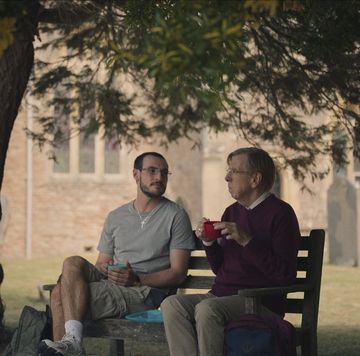Screen adaptations are notoriously tricky business. All too often they fall flat and disappoint the people who loved the original source material. That's why it is such a welcome relief to see HBO has gotten it right so far with Sharp Objects.
Most of the differences between the book and the show stem from the fact that while Gillian Flynn's novel is told in first-person through Camille Preaker’s (Amy Adams) perspective, the show has the freedom to let us occasionally see what happens in other characters’ lives when Camille isn’t present.
The change allows for stronger character development, particularly when it comes to Detective Richard Willis (Chris Messina) and Chief Bill Vickery (Matt Craven). Camille is a key part of almost every scene, though, so audiences are still very much experiencing the creepy world of Wind Gap through her eyes.
The miniseries hasn't veered too far from Flynn's novel, but these are some of the most noticeable changes between the book and HBO series so far.
This post will be updated each week after new episodes air.
Calhoun Day was created just for the miniseries
Calhoun Day, the over-the-top Southern party that commemorates a disturbing piece of town history from the Civil War, never actually happened in the book. Hosted by Adora, Calhoun Day “celebrates” the story of a young Wind Gap woman named Millie Calhoun who refused to give up her husband’s location to Union soldiers, even after they brutally raped her and caused her to have a miscarriage. But ultimately, the party mainly serves as an excuse for the people of Wind Gap to gather on the Crellin family's lawn to drink and gossip. Getting all the characters into one place for such an elaborate event led to some interesting developments that didn’t take place in the novel: Bob Nash and John Keene get into a fistfight, Amma runs away from the party, and Adora tells Richard about Camille’s past.
Camille’s stay in rehab is a much larger part of the show than it was in the book.
A significant portion of the third episode of the miniseries is dedicated to uncovering what happened to Camille after she voluntarily checked herself into a psychiatric rehabilitation facility to deal with her cutting. Camille’s memories show that she developed a close relationship with her teenage roommate, Alice, who is never named in the book. In this flashback, Camille's life is altered when Alice dies by suicide while the two share a room in rehab. After seeing Alice’s lifeless body, Camille ran to the bathroom and broke off a piece of the toilet to carve the word “fix” into her arm. In the book, Camille barely describes her time in rehab, and she appears to have had a very detached relationship with her unnamed roommate.
The show offers more insight into Alan and Adora’s bizarre relationship.
In both the book and the show, Alan Crellin is depicted as soft-spoken and rather sycophantic, catering to whatever will make Adora happy. Because the book is told from Camille’s perspective, the reader only knows the narrator's assumptions about Alan and Adora’s marriage. The show mostly confirms Camille’s belief that there’s a lack of physical intimacy between her mother and step-father. When Alan tells Adora that maybe he should spend the night with her after she injures her hand, she coldly replies, “that won’t be necessary.” Beyond that, the miniseries also gives a brief glimpse into Alan’s frustration with his home life as he steps outside to muffle a scream.
In the HBO series, some aspects of Camille's childhood are shown in greater detail, while other parts are given less attention.
In the book, Camille frequently reflects on her painful adolescence as a way of trying to make sense of how she got to this point in her life. The flashbacks are crucial to understanding why she now lives a mostly isolated life, and her history of self-harm. In the show, we see more clearly how a young Camille was affected by her half-sister Marian's death. Few details are given about Marian's funeral in the book, but in the show, Camille is shown having a meltdown trying to wipe the lipstick off her sister's body, and has to be carried out kicking and screaming. On the other hand, Camille's traumatic memories of early sexual experiences and her frustration with not knowing anything about her biological father are big parts in the book, but have yet to really be addressed in the show.
Detective Richard Willis takes on more of a lead role in the show and is more present throughout the story.
"Kansas City", as Richard is not-so-endearingly referred to by the residents of Wind Gap, is only shown through his interactions with Camille in the book. The miniseries shows more of the detective's work on the murder cases, including one particularly graphic new scene where he pulls teeth out of a decapitated pig head to see how strong the murderer had to be to use the same method on Ann Nash and Natalie Keene. The change was likely made to make more use of Chris Messina's talents and to further endear audiences to Richard by showing that he's not as incompetent a detective as the rest of the town would like to believe.
Camille lives and works in St. Louis in the show as opposed to Chicago, where she works in the book.
It hasn't had much of an effect on the storyline, but Camille worked at the Chicago Daily Post in the book instead of the St. Louis Tribune. Both papers are small, fictional metro-dailies, but the change could have been made to show that Camille wasn't successful enough as a reporter to make it to a bigger market and that she didn't end up that far away from home.
The scene at Natalie Keene's funeral was changed in the show, but for a good reason.
As Camille stands up at Natalie's funeral service, she rips the black dress she borrowed from her mother and runs out of the church. It's a seemingly innocuous addition to the story that didn't appear in the book, but later, we see her sewing sewing the dress back together and driving her finger into the needle—another hint at the character's desire to self-harm.
The HBO series depicts Camille's relationship with the Keene family as less contentious.
A major roadblock to Camille's reporting in the book is that Natalie's parents, understandably, don't want to speak with her about their daughter's death. Camille gets yelled at several times on the phone when asking for quotes, or when Mrs. Keene hears what Camille plans to print. In the show, Camille openly talks about the circumstances of Natalie's murder with Mr. Keene at the wake, and hasn't interacted Mrs. Keene at all.

Elena Hilton is the assistant editor for Esquire.com, where she manages Esquire's social media and writes about culture and politics.














